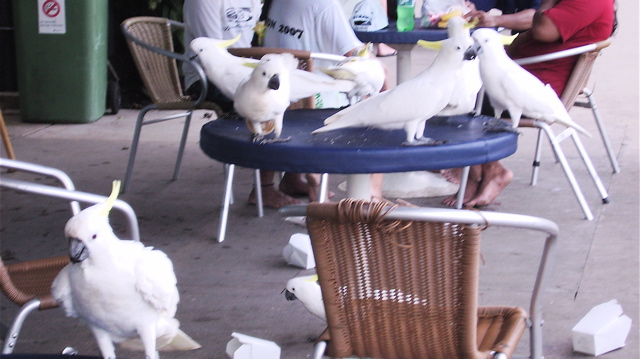Published in the Ocean Watch column, Honolulu Star-Advertiser © Susan Scott
Jun 15, 2007
Years ago, an editor said to me: “Susan, you write about humpback whales like everyone sees them. I’ve lived here all my life and have never seen one.”
“You could,” I said. “but you do have to look at the ocean.”
I remembered this conversation last week as I stared at the sea for nearly two days and saw not one animal — not a bird, a dolphin or a leaping fish. This wouldn’t be worth mentioning, except I was sailing inside Australia’s Great Barrier Reef. If this is the largest living thing on Earth, I thought, then where is all the life?
And then, just when I stopped looking, there were the animals, above me, around me, at my feet, on my boat. It wasn’t what I expected, which made it all the more fun.
The wildlife showed up after Scott, my friend and crew, and I decided to pull into a marina on Hamilton Island, one of a group called the Whitsundays. The boat was having electrical problems and our cruising guide said we might find help at Hamilton.
We did. We also found animals. Big mullets with bright white lips swam around the boat, nibbling growth off the piers and pilings. Tiny welcome swallows darted in and out of the rigging to greet us and red-beaked silver gulls perched on neighbor boats waiting to see what tidbits we might offer.
But it wasn’t until we walked ashore looking for the harbor office that we hit the jackpot. There, at a fish and chips café, dozens of sulfur-crested cockatoos perched, flew and screeched. “Chips! Chips!” they yelled.

Amazed, we stopped and watched a flock of these large white parrots land on a recently vacated table and demolish the leftovers. A diner held out the remainder of a chicken breast. A cockatoo snatched it and took its prize to a post above us. “Look out for falling chicken bones,” Scott joked as we looked up. Plop! The bone fell at our feet.

Also arriving for a snack were two rainbow lorikeets, surprisingly dominant over the larger cockatoos.
Later, while walking to the highest point of Hamilton for a view of the Whitsunday Islands, I saw kookaburras, curawongs, magpies and crows. When I returned to the boat, cockatoos had taken over our dock, calling to one another from rigs, mast tops and booms.
After Hamilton, we anchored at nearby Whitehaven Beach, famous for its white silica sand. Complementing this brilliant shore were several white sea eagles soaring overhead.
On this popular 2-mile-long beach we stopped to admire several kinds of ghost crab homes, two beached fireworms, eight oyster catchers, and a pair of sandpiper parents guarding two chicks. The chicks’ tiny bodies on their exceptionally long legs reminded us of bugs on stilts, and we moved in for a closer look. When the frantic parents began faking injury to divert our attention, we moved on.
At the far end of the beach we found an army of millions. Blue soldier crabs, about the size of a quarter, covered the sand exposed at low tide. When we approached, these well-named crabs ran from us in groups of thousands, as ordered as schooling fish.
That all this wildlife lives among buildings, boats and beach walkers says everything about marine sanctuaries. When we protect wildlife, it comes to us. And sometimes, we don’t even have to look at the ocean to see it.